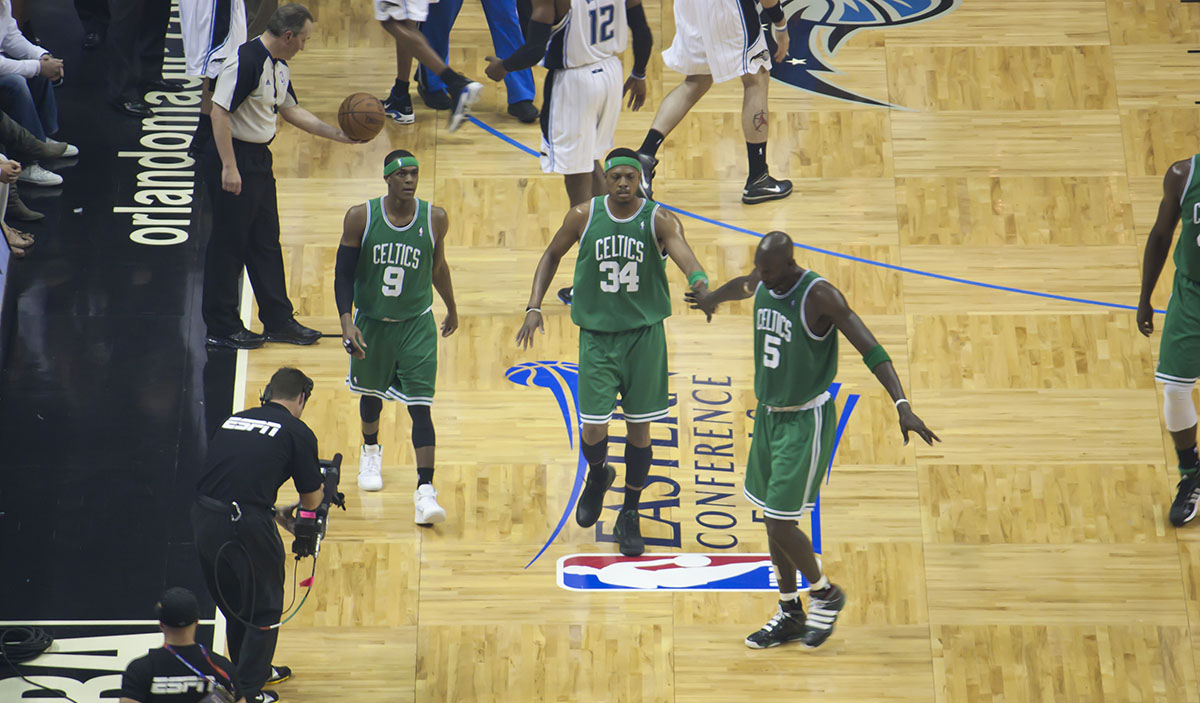The Garnett and Pierce Trade Has Never Looked Better

BOS-ORL017 by Michael Tipton on Flickr/Creative Commons
The Celtics have an opportunity this season to accomplish a rare feat in professional sports: Compete for a playoff spot and obtain a high pick in the draft. Three seasons later, the Kevin Garnett and Paul Pierce trade continues to bear fruit.
When Danny Ainge shipped Garnett and Pierce to the Brooklyn Nets three summers ago, some people questioned whether he had waited too long to break up the new Big Three. Red Auerbach hung onto Larry Bird, Kevin McHale, and Robert Parish until the bitter end of their run, and it wound up setting the franchise back for nearly a decade—Boston didn’t win a single playoff series from 1993-2001. It seemed as if Ainge was repeating the same mistake, given that the listless Celtics were dismantled by the Knicks in the first round of the playoffs the previous spring. But as it turns out, it’s difficult to imagine Ainge getting a better return for his two aging stars.
The C’s received three first-round picks (2014, ’16, ’18) and the ability to swap first-rounders with Brooklyn in 2017. That looked good at the time and looks great today, considering Nate Silver’s FiveThirtyEight projects the Nets to be the worst team in the Eastern Conference this season. But the other prize of the deal was a trade exception that came Boston’s way, which Ainge managed to turn into Isaiah Thomas, the team’s undersized, yet dynamic leading scorer.
The Celtics acquired Thomas at the deadline last season in exchange for the Cavaliers’ 2016 first-round selection and guard Marcus Thornton. The C’s scooped up that pick and Thornton along with starting center Tyler Zeller two summers ago in a three-team trade with the Cavaliers and Nets. They were able to facilitate the deal by using their aforementioned $10.4 million trade exception. (In the NBA, a trade is only permitted if the salaries going both ways match up. A trade exception allows a team to absorb that salary equivalent without surrendering any players. Thus, the Celtics were able to take on Zeller and Thornton, which freed up enough money for the Cavaliers to sign LeBron James.)
Confused yet? That’s OK. Here’s how the Garnett and Pierce trade ultimately breaks down, based on what each team got:
Nets: Kevin Garnett, Paul Pierce, Jason Terry (none of whom are still with the team)
Celtics: Nets 2014 first-round pick (used to select James Young), Nets 2016 first-round pick, Nets 2018 first-round pick, ability to acquire the Nets’ 2017 first-round pick, Isaiah Thomas and Tyler Zeller. (Assorted flotsam and jetsam such as Gerald Wallace, Kris Humphries, MarShon Brooks and Keith Bogans were part of the package, too, but they’re no longer in Boston.)
The Celtics went on a run after bringing in Thomas last season, winning 24 of their final 36 games to sneak into the No. 7 seed. Thomas was the catalyst for the Celtics’ resurgence, averaging a team-leading 19 points per game off the bench.
Thomas was also the star of the season-opener Wednesday night, netting 27 points in the Celtics’ 112-95 win over the perpetually rebuilding 76ers. Unlike the Celtics, the 76ers have to work for their potential lottery selections. They’ve only won 37 games over the last two seasons, and are expected to be putrid yet again this year.
Oftentimes, suffering through years of woeful basketball is the only way for a team to build itself into a championship contender in the NBA. If you can’t attract major free agents, the only way to acquire a star is at the top of the draft. You have to do a lot of losing to have the best chance at landing one of those high lottery selections.
But thanks to the Nets’ projected futility, the Celtics can gun for 50 wins and a middle-tier playoff seed without sabotaging their future. Meaning, Celtics fans can watch exciting basketball and not worry about their team being mired in mediocrity for years to come. The Garnett and Pierce trade is to thank for this marvelous circumstance.


